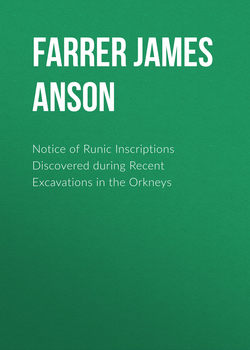Notice of Runic Inscriptions Discovered during Recent Excavations in the Orkneys

Реклама. ООО «ЛитРес», ИНН: 7719571260.
Оглавление
Farrer James Anson. Notice of Runic Inscriptions Discovered during Recent Excavations in the Orkneys
PREFACE
MAES-HOWE
The Excavation of Maes-Howe
Barrows at Bookan
Mounds at Stennes
Tenstone
APPENDIX
Readings of the Inscriptions by ProfessorsStephens, Munch, Rafn
Отрывок из книги
Early in the month of July 1861 I was enabled, by the kind permission of my friend David Balfour, Esq. of Balfour and Trenaby, to put in execution a scheme long contemplated, but from various circumstances unavoidably delayed, the excavation of some of the great tumuli in the neighbourhood of the Stones of Stennes, or Ring of Brogar. I had in the year 1854 partially explored one of considerable size on the east side of the great circle of stones, which stands on the west shore of the Loch of Harray. No discovery, however, of any importance was then made.
Some days were devoted to excavations close to Stennes, to which allusion will afterwards be made, but as several gentlemen of well-known antiquarian reputation from Edinburgh and Aberdeen were expected, and as I was desirous of having the benefit of their experience and advice, I determined at once to commence operations on the great tumulus of Maes-howe, the subject of this notice. My attention had been particularly called to this tumulus by Mr. Balfour, whose decided opinion that a careful examination might result in some important discovery, afforded me great encouragement, as I well knew that he had for many years taken considerable interest in Orkney antiquities, and his opinion that Maes-howe was a sepulchral chamber, appeared to be confirmed by local traditions.1
.....
The tumulus is about 92 feet in diameter, 36 feet high, and about 300 feet in circumference at the base. It is surrounded by a trench 40 feet wide, and varying in depth from 4 to 8 feet. It is situated on the north side of the new road leading to Stromness from Kirkwall, being about 6 miles from the former, and 9 from the latter place. It is about 200 yards distant from the road, and a mile and a half from the Stones of Stennes. It has undoubtedly been entered at some remote period, probably by the Northmen, who, as is well known, were not deterred by feelings either of religion or superstition, from opening and ransacking any place likely to repay them for their trouble. Whether they were the first to break into the building, or whether they found it in a state of comparative ruin, the natural result of great antiquity, can now only be matter of conjecture. It is obvious that little respect has been paid to the dead, since the stones used for closing up the cells, in which it is supposed they were deposited, were found torn out and buried in the mass of ruins filling up the interior of the chamber to which these cells are attached.
The passage leading to the central chamber is 2 feet 4 inches wide at its mouth, and appears to have been the same in height, but the covering stones had been removed, or had fallen in for about 22½ feet. The passage then increases in dimensions to 3¼ feet in width, and 4 feet 4 inches in height, and continues for 26 feet, when it is again narrowed by two upright stone slabs to 2 feet 5 inches. These slabs are each 2 feet 4 inches broad, and immediately beyond them the passage extends 2 feet 10 inches, and then opens into the central chamber. Its dimensions from the slabs to its opening into the chamber are 3 feet 4 inches wide, and 4 feet 8 inches high. At the commencement of the passage there is a triangular recess in the wall about 2 feet deep, and 3½ in height and width, in front and opposite to it in the passage, a stone of corresponding shape and dimensions, suggesting the idea that it might have been used to close the passage, and that it was pushed back into the recess in the wall when admission into the chamber was desired. From this recess to the chamber, the sides of the passage, the floor and roof, are formed by four immense slabs of flagstone; three of these stones are broken, and the fourth slightly cracked.
.....